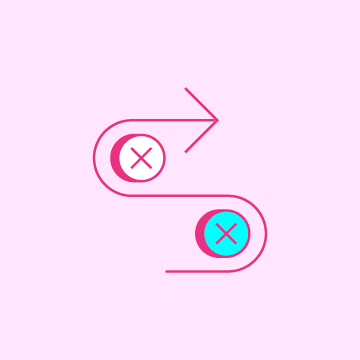What is Design Thinking?
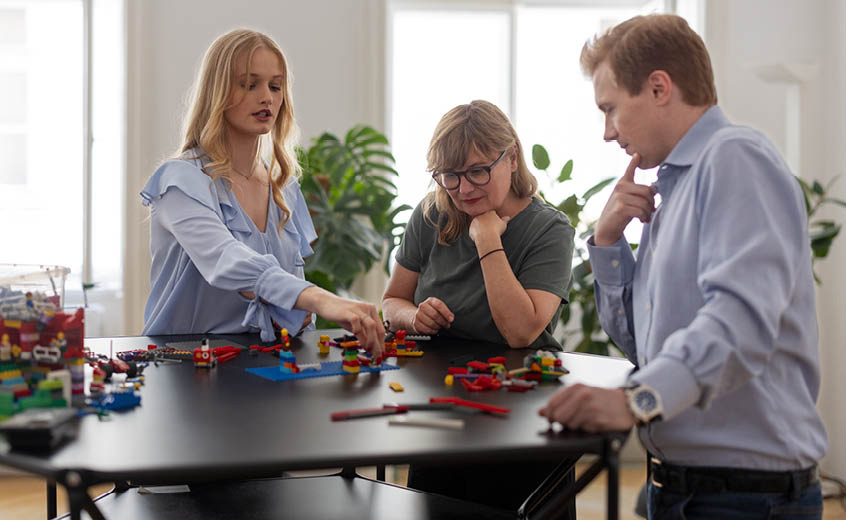
Design Thinking enables companies and organizations to better understand complex problems and issues and solve them in a structured process. We show you the six phases that make up the design thinking process and the methods design thinkers use to immerse themselves in the needs of users and achieve the most practical results possible.
Content
- Design thinking explained simply
- Where does design thinking as a method come from?
- Fast results thanks to small teams
- Design thinking methods
- The design thinking process
- Change by design with Wonderwerk
Design Thinking explained simply
Design Thinking is an iterative method or process for solving complex questions and problems. The Design Thinking process consists of a sequence of six steps, also known as Design Thinking phases, in which a team of five or six people systematically works through the question and arrives at creative solutions. The most important feature of the Design Thinking method is its point of view:
The goal is to develop a deeper understanding of the problem in order to find a solution that is compelling from the customer’s perspective.
The applications of Design Thinking are numerous. They range from the question of why a service is less well accepted by certain target groups than by others, to the development of new products, to problems related to strategy development or agile transformation.
Where does Design Thinking as a method come from?
The term “Design Thinking method” is not really accurate. Strictly speaking, design thinking is a compact set of methods “poured” into a process. These methods originate from an idea in the 1980s that became internationally known through Richard Buchanan:
That the intuitive and user-centered work process of designers could be transferred to organizational development, or that the creative process of designers could provide new impulses for organizational development. In this context, we also speak of design management or management by design.
The leap from design management as an interdisciplinary field with a long history to Design Thinking as a method that is now used primarily in innovation management was marked by three Stanford professors: Larry Leifer, Terry Winograd, and David Kelley. In 1991, Kelley co-founded the design and innovation agency IDEO with industrial designer Tim Brown.
That same year, the first official conference on the subject was held under the name Design Thinking Research Symposium. In 2003, Kelley, Leifer, and Winograd founded the d.school at Stanford, which was renamed the Hasso Plattner Institute of Design two years later after SAP founder Hasso Plattner became involved.
Design Thinking as a practical method
David Kelley and Tim Brown have shaped the understanding of Design Thinking as a method that combines the fulfillment of user needs with what is technically feasible and economically viable. In other words, it is not enough for the customer to be satisfied. With design thinking, companies and organizations develop solutions that are both convincing from the user’s point of view and market-oriented.
It is this combination of design (structured design process) and thinking (examination of economic and technical feasibility) that makes innovation successful. (Paraphrased from Tim Brown: Design Thinking. In: Harvard Business Review. June 2008)
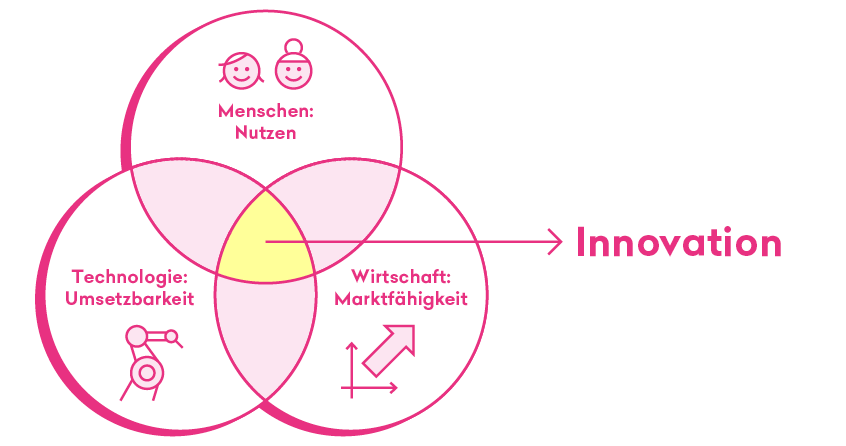
Although Leifer, Kelley, and Brown are often referred to as the “pioneers” of Design Thinking, there are also many female design thinkers who have contributed significantly to the popularity of the method. Today, researchers such as Claudia Mareis, professor of design and knowledge history at Humboldt University (Berlin), and Mariana Amatullo, professor of strategic design and management at Parsons School of Design (New York), are shaping the academic conversation about Design Thinking and the many applications of this innovation method.
Fast results thanks to small teams
New ideas thrive best in a fertile environment of diversity. In order to successfully shift perspectives into the user role, it is therefore necessary to have not only a structured process and a work environment that promotes creativity (e.g., a new work environment), but above all small and ideally multidisciplinary teams. For this reason, Design Thinking teams usually consist of five or six people from different functions and with different professional backgrounds. The teams develop specific questions from the user’s point of view and work toward results that are as concrete (= tangible) as possible.
The results are materialized in the form of prototypes or (for example, in organizational development) using Lego Serious Play and presented to representatives of the respective target group.
Feedback from the test group(s) is incorporated into the next design round, enabling the teams to move step by step toward the final solution. Working in short cycles and prototyping as early as possible or conducting retrospectives as early as possible is something that Design Thinking shares with OKR (Objectives and Key Results) as a management and goal management framework. Depending on the scope of the project, it is also possible to work with several Design Thinking teams that regularly exchange their results.
Design thinking methods
Successful design thinkers find answers to questions that haven’t been asked-because no one knew they needed to be asked. To do this, design thinking teams need to step out of their own perspective and constantly refer back to their target audience, immersing themselves as fully as possible in the needs and problems of the users.
Designers have a variety of tools and methods at their disposal for this process, which are selected and often combined depending on the question or problem at hand. Design Thinking methods that are used in virtually every innovation and ideation process include, for example
- Interviews: Personal conversations with as many different participants as possible are one of the most important Design Thinking methods. It is crucial for the success of this method that no leading questions are asked: The goal is to develop a better understanding of the problem or the needs of the target group without presenting any solutions.
- Engagement/participatory observation: Participatory observation is an important addition to interviews, diary studies, etc., because it allows teams to immerse themselves in the experiences and needs of participants without any “filters.” To this end, everyday situations are reenacted to find anchor points for solutions or new ideas. A similar effect can be achieved with the help of video material or through so-called shadowing (accompanying a person through their everyday life).
- Personas: Personas give potential customers a face, including their desires, dreams, goals, and life circumstances. The character descriptions are created based on real user data and help teams identify with the target group on an individual level.
- Empathy map: The empathy map can be used as an alternative or supplement to personas. The aim here is not only to gain a better understanding of the target group’s needs (gains), but also to get a feel for their obstacles (pains). The map consists of six fields which, in addition to needs and obstacles, cover the areas of seeing (environment), hearing (perception), thinking & feeling (thoughts) and saying & doing (actions). The team works its way from field to field in a workshop setting and fills the empathy maps with the data and insights available about the respective target group.
Point of View
Point of View is a method frequently used in Design Thinking projects for organizational development. It allows the team to understand and adopt the point of view of each person involved in the respective process. This method is often used when it is not entirely clear why certain processes are not working or why gaps in communication are occurring.
First, all those involved in the process (e.g., as Post-its) and their relationships to each other (in the form of arrows) are displayed on a board or whiteboard. Then, specific interactions and processes between these people are superimposed (e.g., using carbon paper). This often reveals where processes are disrupted, communication channels are interrupted, or important contacts are not even established in the first place.

Future(s) Thinking
A relatively new method in the Design Thinking toolset is known as future thinking or future(s) thinking. Future thinking involves identifying specific signals and indicators in the present that point to possible changes in the future—and using these possible future scenarios to change the present. Teams collect indicators of possible changes and developments by conducting qualitative surveys in workshops and performing consistent trend analysis.
You can find more information about this method in our blog article Future Thinking – shaping the present from the future.
The Design Thinking process
The Design Thinking method culminates in the design thinking process. This process consists of six phases, which the respective team goes through until the solution is materialized and successfully tested on the correct target audience. It is therefore an iterative process that focuses on the needs of the user. The six phases essentially follow the work process of a designer, who intuitively approaches the solution starting from a beginner’s mindset. The three main tasks in the design thinking process are
- Understanding: The team defines the initial situation, identifies the problem space, and develops a basic understanding of the problem or issue.
- Observe: “Observe” means immersing oneself deeply in the problem or needs of the users.
- Find ideas: The team develops ideas on how problems could be solved, evaluates them, and prioritizes them.
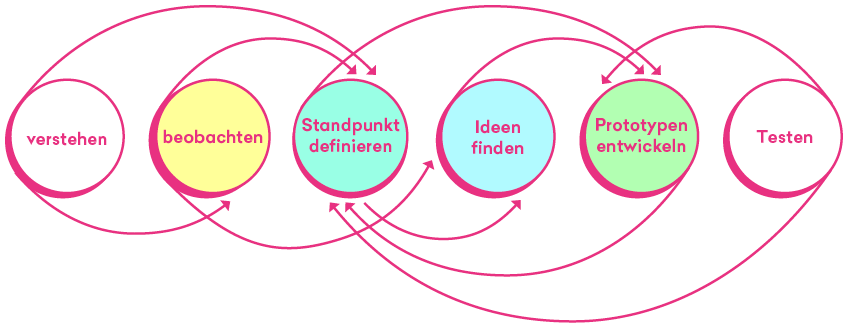
Phase 1 – Understanding and defining the problem area
The first phase of the Design Thinking process is about getting all team members “on the same page.” The team must develop a common understanding of the problem or issue and define both the framework conditions and the solution horizon. At the end of the first phase, everyone involved has an idea of how the problem presents itself from the user’s perspective. In the next phase, these hypotheses are tested to see whether they are accurate or whether they fail to reflect the reality of the users’ experience.
Phase 2 – Immersion in the world of needs
In the second phase of the Design Thinking process, team members immerse themselves in the problems and needs of users by using methods such as interviews, focus group discussions, and/or participatory observation. They pay particular attention to workarounds that customers themselves use to try to better adapt their environment to their needs. Workarounds and improvised solutions are often an indicator that there is a high demand for an optimal solution.
It is crucial that the team critically examines each of the hypotheses developed in phase 1: Which assumptions are actually true and which assumptions do not stand up to comparison with the reality of the users? Only those hypotheses that have proven to be true are incorporated into the design of potential solutions.
Phase 3 – Define conceptual framework
In the third phase of the Design Thinking process, the team brings together the assumptions from phase 1 and the impressions and insights from phase 2 and defines a common position: The problem horizon from phase 1 becomes a specific question that concerns a specific group of users. In this phase, the team not only pinpoints the problem, but also defines the ideal user group for the solution that is yet to be developed. With this newly created persona, the process moves on to the next phase.
Phase 4 – Brainstorming and initial sketches
The fourth phase of the Design Thinking process involves developing ideas for how to solve the problem for the persona defined in phase 3. It is important that the team first collects as many ideas as possible without evaluating them directly. Techniques such as brainwriting or idea sprints enable teams to break away from best practices and existing patterns and think outside the box. In this phase, it is also expressly permitted to build on the ideas of other team members or develop them further.
Only when as many ideas as possible have been collected is it time to sort them out. Only those ideas that are user-centered, technically feasible, and economically viable make it to the next round: prioritization. Prioritization is one of the most difficult tasks in the design thinking process because prioritization inevitably means that even good ideas die. As a rule, only those ideas that offer the greatest possible benefit with the least possible effort should make it to the fifth phase: when in doubt, simple is better than complicated.
Phase 5 – Materializing ideas (prototyping)
Phase five of the Design Thinking process is about making the best idea(s) from phase 4 experiential for others: this is where the team develops (initial) prototypes. Only when the prioritized idea(s) can be tested on representatives of the target group does it become clear whether the solution really has potential. It is crucial that the prototype invites identification:
In phase 6, the test group must be able to think their way into the solution or put themselves in its place – this is the only way to generate feedback that the team can actually work with. There are no limits in terms of design and materials: a prototype that exists “only” on paper can work just as well as a prototype made of Lego bricks. The main thing is that it is fit for purpose and does not cost the team too much time or energy.
Phase 6 – Testing, feedback, and conclusion
In phase six of the Design Thinking process, the team presents its creative solutions in the form of prototypes to a group of test customers who belong to the ideal user group defined in phase 2. Prior to the presentation, the team members define what needs to happen for the respective prototype to be considered successful. It is important that a prototype that does not work is not seen as a failure: phase six does not aim to communicate the prototype as the optimal solution, but rather to obtain genuine and critical feedback. To this end, the team observes how the test group interacts with the prototype: What questions do they ask? Which aspects do they find particularly striking? Why do they ask these questions?
Depending on how the test group reacts to the prototype, the design thinking process then starts again from the beginning (because, for example, important flaws in the solution only became apparent through the prototype) or the solution works and can be implemented. In some cases, the team only needs to return to phase five and adapt the prototype.
A complete solution in 5 days: the Design Sprint
A popular variant of the design thinking process originates from digital product development at Google Ventures: The Design Sprint, developed by Jake Knapp in 2010, allows just five days to define a problem (day 1), sketch out different solutions (day 2), prioritize the ideas (day 3), build the prototype (day 4), and test the prototype (day 5).
As with any design thinking process, the Design Sprint ends with either a solution that is ready for implementation, a prototype that requires final adjustments, or the realization that the prioritized idea should not be pursued further. In the latter case, the Design Sprint starts over from the beginning. At Google, the Design Sprint involves product managers, stakeholders, and technical experts.

Change by Design with Wonderwerk
Wonderwerk Consulting operates at the intersection of innovation, management by design, and organizational development. We have been successfully supporting change processes in companies and public organizations for many years and apply design thinking in a targeted manner to both organizational and strategic issues.
As pioneers of design thinking in the DACH region, we are convinced that this innovation method can deliver valuable results and open up innovative solutions for every organization and every question or problem.
We also pass on our expertise in our design thinking certification program to employees who want to use design thinking in their company or organization.
Wonderwerk as a Design Thinking Coach
At Wonderwerk, we are convinced that problems are fundamentally systemic in nature and that an expanded perspective is needed to identify the root causes of a problem. In doing so, we often uncover further weaknesses in processes and/or structures and resolve them before they can become problems.
As Design Thinking coaches, we take great care to clearly separate the interests and needs of the organization we are working for from the needs and interests of the users: for an organization that develops in line with user needs rather than apart from them – and for change that matters.
Walking in your customers shoes
Why does a particular service work for one generation of people but not for the next? We explored this question in our latest success story for the Austrian Public Employment Service.
To find out what it takes for the youngest generation on the labor market, the so-called Gen Z, to make use of the AMS’s services as reliably as older generations, we used various design thinking techniques such as sound walks, storytelling research, and co-creation.
We consistently involved the user group in all processes in order to gain an accurate picture of their experiences and needs and, together with the AMS, create services that really meet the needs of teenagers and young adults.
Contact
Anna-Maria Hausdorf
anna-maria.hausdorf@wonderwerk.com
Book your free consultation now!
Our Design Thinking trainings
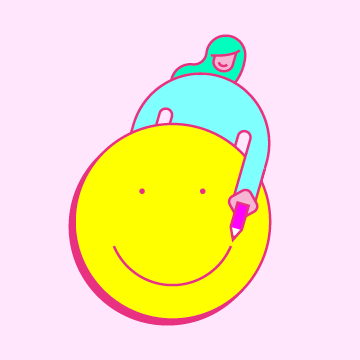
Design Thinking

Design Thinking
